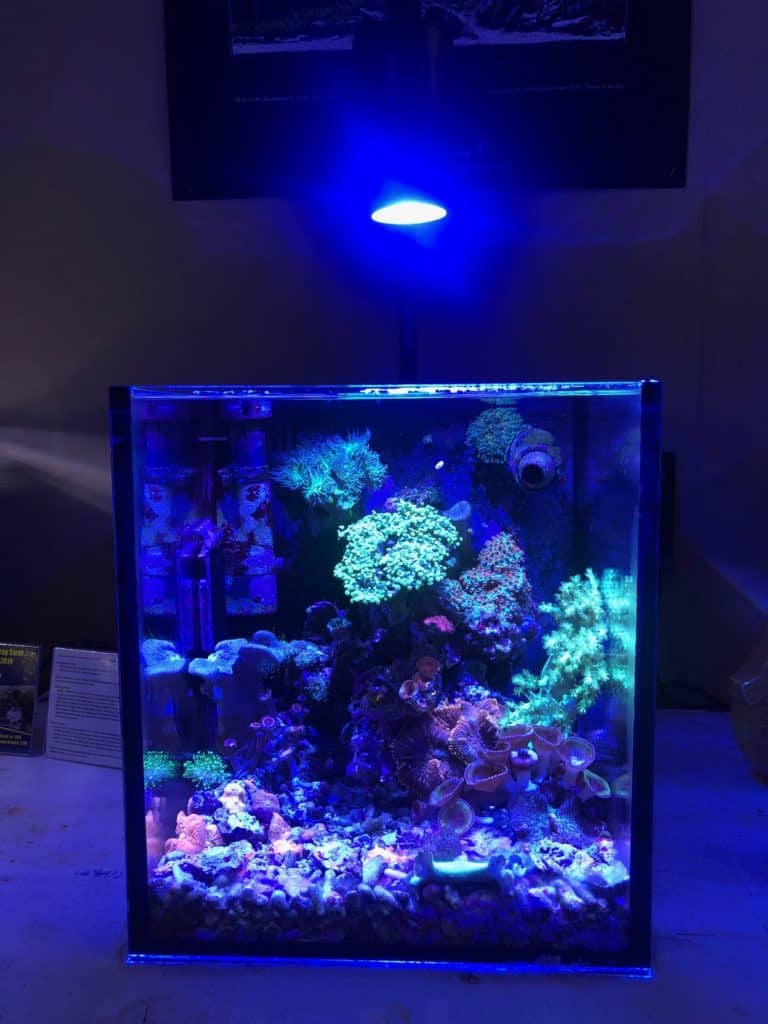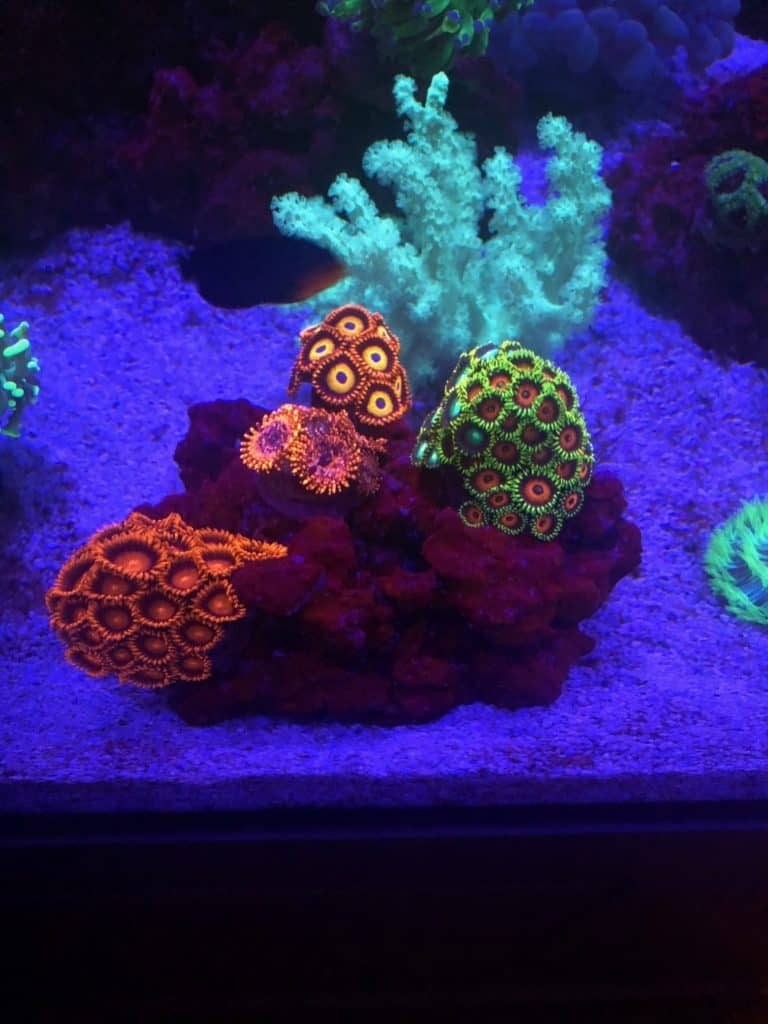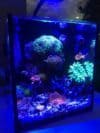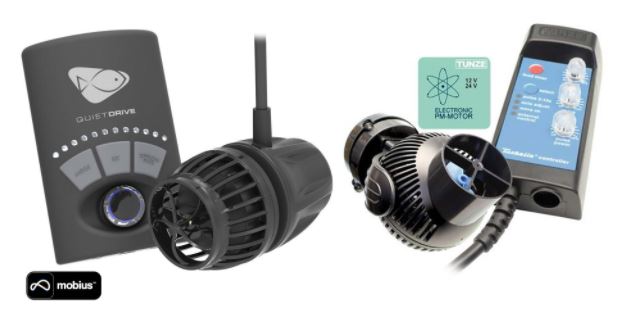A low-maintenance reef tank is an aquarium that can sustain stable water parameters and healthy fishes, invertebrates, and corals while requiring as little as a few minutes of maintenance per week.
So you’ve seen beautiful saltwater reef tanks and thought about getting into the hobby. Maybe you have been in the hobby but are looking to move to a low-maintenance reef tank to reduce the work you’re currently putting into your aquarium.
I’ll outline how to get there in this article, but first, let’s define what exactly is a low maintenance reef tank.
What is low maintenance and how do we get there?
Six steps to creating a low maintenance tank are:
- Buy a tank that most closely correlates with the size and number of fishes you intend to have in your reef tank.
- Select fish that are compatible; and that don’t have to share the same tank areas. Additionally, select fish that can provide a utilitarian purpose in your reef tank when possible.
- Select corals without hard skeletons – called soft corals or softies and avoid corals with skeletons such as LPS and SPS.
- Avoid complicated livestock!
- Buy lights to provide the PAR and spectrum required by the corals you have pre-selected for your tank.
- Add powerheads that will move water around the tank efficiently, and reach all areas of the tank.
These six steps are based on the following premise: 1) A low-maintenance reef tank is your number one priority. 2) That it is all about enjoying your tank more – and thinking about it less
Read on for more explaining how these six steps significantly reduce reef tank maintenance!
Remember, when your maintenance regimen is under control and manageable, the intimate interaction with your reef tank and its beautiful animals during routine maintenance can actually be half of the fun.
Think about ‘What is a reef tank?’ and the potential maintenance headaches are obvious!
What is a reef tank? When you consider the potential complexities of creating your own reef environment with the wide variety of living creatures (intended and unintended) you may have in your aquarium – it is pretty easy to see how maintenance could become a tedious everyday obligation. It can turn into a struggle to keep everything alive that you want and to eliminate pests, algae, and other things you don’t want.
The truth of the matter is that your reef tank really is essentially a glass box of water. How well you can keep your box of water’s chemistry and critical parameters in balance will directly impact how much maintenance is required and how much fun you have with your reef tank.
In your box of water, you may be placing a substrate at the bottom such as dry or live sand, crushed corals, or even dry rock rubble – or you may even decide to go bare bottom. You will also be placing the dry or live rock in your reef tank to host your biological filtering bacteria, as well as a base for some of your corals and places for your fish to play, hide, and sleep.
Then, on top of that, you are adding your livestock, which consists of fishes, invertebrates, corals, and more.
With all that – how are we possibly going to have a low maintenance reef tank?
The first step to a low maintenance nano reef tank: Don’t stab yourself in the back!
So I have good news and bad news… The good news is that you are 100% in control of what it takes for you to have a low-maintenance reef tank. The bad news is that it means that you are 100% to blame if your aquarium maintenance becomes a nightmare! So the primary focus at the start is to be self-aware and honest with yourself about what type of reef you want and how much time you will have available for enjoyment and maintenance.
Before you buy a thing – you have to make decisions about what you want from your tank – including facing all of your predetermined needs like tank size and shape, where the tank will be placed, and what kind of fishes, corals, and invertebrates you have to include in your reef tank.
My article ‘Easy Quick Start Reef Tank Guide‘ is a great resource of what it takes to set up your reef tank.
It’s these first decisions that will make or break your chances of having a low-maintenance reef tank! Take your time. It is often said that ‘nothing good happens fast in reefing.’
You can recover from any situation – but it’s obviously more difficult than getting it ‘mostly right’ the first time.
I personally am very impatient, and every tank I build, I cut as many corners as I think I can get away with to get the tank up and running as fast as possible. I am constantly dealing with the consequences of those actions – so no one knows more than me what it takes to make things too complicated!
Along the way, I have had many nights where I think ‘if I had only…’ It’s that ‘I wish I had….’ hindsight that I am sharing with you today.
Low Maintenance Nano Reef Tanks: the EASY way!
The steps outlined below to a low-maintenance reef tank are based on the following premise: Your number one priority is that you want a low-maintenance reef tank that is all about enjoying your tank more – and thinking about it less.
Step 1: Select the right size reef tank
Buy a tank that most closely matches the size and number of fishes you intend to have in your reef tank. If the tank is on the larger side of the nano category (20 gallons+), I recommend one with a
How does this reduce maintenance?: A reef aquarium overloaded with fish will create a bioload that necessitates additional and specialized filtration to overcome the excess of phosphorus and nitrogen in the form of phosphates and nitrates. These nutrients are the prime contributor to excess algae that can create a constant maintenance nightmare. If you plan on having 10 fish – you shouldn’t be thinking about a nano tank.
Coral Dominant: A nano tank, to be low maintenance, should be focused on coral more than fish.
Nano Reef Adviser
When tanks have to manage large bioloads, the enhanced filtration required can include protein skimmers, refugiums, algae scrubbers, chemical additives, advanced filter media, and more! Managing, maintaining, and monitoring this extra equipment and media adds to maintenance that could be avoided by simply managing the bioload. In case I didn’t say it clearly – manage the bioload. Say it with me out loud – just kidding.
Bioload hack: If you add your fish over time (think weeks and months,) you will be able to monitor your phosphate and nitrate and see how each new fish affects your testing results. If (that’s a big ‘IF’ not a little ‘if’) you have phosphate and nitrate readings near 0.00 – then you can add fish (one or two at a time) until your levels rise. A great LOW MAINTENANCE target for phosphate is about 0.03 ppm and nitrate between 3 and 10 ppm.
Nano Reef Adviser Hack
Warning!: If you overfeed your fish, you will greatly reduce the amount of fish you can have in the reef tank and still hit your lower target phosphate and nitrate numbers.
In my current shallow reef 60-gallon tank, I had to add 5 fish (3 green Chromis, 1 Cherub Angel, and 1 Randall’s Goby) above and beyond what I had originally planned in livestock – to get my nutrients above 0.00. In our nano tanks – we don’t usually get that kind of luck!
Check out my article on the best low iron rimless nano aquariums.
Step 2: Select the right low maintenance saltwater fish
Select fish that are compatible that don’t have to share the same areas of the tank, providing a utilitarian purpose when possible.
How does this reduce maintenance?: A tank of peaceful fish (for example) that are mixed between those that live near the bottom rest on or hide in and out of rocks, those that school, and/or those that hover will reduce fighting for territory and, therefore, stress the fish. The lack of stress will help reduce the potential for illness and disease that would otherwise not affect a healthy fish. Working to treat an entire tank of sick fish is a lot of maintenance.
Fish hack: If the fish you select is an alga or pest eater, it actually can assist you with your maintenance by doing what nature intended.
Nano Reef Adviser Hack
I added a yellow Coris wrasse to my tank. Not only is it a beautiful yellow fish that helps stir up the sand bed (they will hide/sleep in the sand,) they also will eat pests that can damage and irritate corals. I get to watch him nibbling at the sand and rocks all day, helping me maintain my tank.
Step 3: Select easy-care corals
Select coral without a hard skeleton – called soft corals or softies and avoid corals with skeletons such as LPS and SPS. Yes, there is a crazy assortment of beautiful corals that you will want to put in your tank the second you see them – but if you focus on corals with higher demands – your maintenance goes up! Additionally, soft corals will provide the movement in most reef tanks as they rock back and forth in the water movement in contrast to most LPS and SPS corals, which generally offer little movement to the eye. Softies are also usually much less expensive – which means you can fill your tank with frags or buy larger specimens that will quickly turn your reef tank into a show stopper.

How does this reduce maintenance?: As your corals with skeletons grow, they become more dependent on the precise management of alkalinity, calcium, and magnesium (not to mention other trace elements.)
As you add corals and/or your early corals grow larger and larger, it is routine to begin some management techniques to maintain the required elements
Furthermore, many corals are known for having more pest issues – so research before you buy
Managing, maintaining, and monitoring this extra equipment and supplements adds to maintenance that could be avoided by selecting corals without skeletons, low pest potential, and photosynthetic.
Many awesome coral choices will fit the bill and provide beautiful colors and movement in your reef tank. Examples include zoanthids, leathers, mushrooms,

Coral hack: If you select softies as the majority of corals in your tank, you will be able to add a limited number of LPS corals (likely still no SPS like Acropora) – but only to the extent that your water changes are sufficient to replace depleted elements. If you keep your LPS coral limited to the size and number where water changes will adequately manage the alkalinity, calcium, and magnesium elements, then it is no additional maintenance to have those corals in your tank.
Nano Reef Adviser Hack
Additionally, some corals NEED to have supplemental feeding, so stick with photosynthetic corals and are generally not REQUIRED to be fed to thrive. Select corals that can obtain all of their needed nutrients from the water column to keep them low maintenance.
Step 4: Avoid complicated livestock in your reef tank
This one is short and sweet: Avoid complicated livestock!
How does this reduce maintenance?: When you add invertebrates such as anemone, non-photosynthetic coral, or fish that are finicky eaters or require special diets, you have just bought into additional feedings, multiple food items,/types, and potentially even trying something like culturing copepods to meet the demands of your new inhabitants. Please keep it simple and limit the number of feedings and types of foods to reduce maintenance.
Read my guide on the ‘Best Clean-up Crew for a Reef Tank‘
Step 5: Reef lighting is critical
Buy lights to provide the PAR and spectrum required by the corals you have pre-selected for your tank.
How does this reduce maintenance? Struggling with corals’ health can lead to moving corals from place to place to find their ‘happy place.’ Trying a series of panic relocation moves to try and rescue the coral can trigger more stress on the coral and potentially livestock loss. Match the proper lighting to your actual corals so that worry and maintenance are reduced.
Check out Marine Depot’s great selection of the latest lighting set ups.
Step 6: Set up proper water flow
As tanks get larger, the return pumps alone cannot be counted on to provide all of the water flow necessary for the tank. Add powerheads that will move water around the tank efficiently, and reach all areas of the tank.
How does this reduce maintenance?: Good flow around the tank eliminates dead spots where detritus may build up. This will keep the detritus from decaying by allowing the filtration system to filter the detritus from the water column. Additionally, the improved water flow will benefit corals greatly by delivering nutrients and helping them with elimination.
So there you have it! 6 steps to help you build a low maintenance reef tank – the easy way.
Ultra-Low Maintenance Reef Tank
However, if you can’t stop yourself from complicating your tank, don’t worry. The hobby has developed many ways to meet demanding reef tank requirements.
You can add automated equipment, including aquarium controllers, auto feeders, automatic water changes, auto water top-offs, and more. Installing this equipment definitely is much more complicated. However, it will add functionality that will allow you to manage and control your reef tank remotely.
Can you imagine feeding your fish, topping off your tank from evaporation, and dosing important nutrients and elements while you are on vacation? Well, if you can afford the cost of these options – and have a little bit of a DIY personality, you can add these options to turn a complicated reef tank into an ultra-low maintenance reef tank as well.
The video below is a summary of the lessons learned from Bulk Reef Supply’s ultra-low Maintenance reef tank experiments.
Summary: A low maintenance reef tank – the EASY way!
A low maintenance reef tank needs to be a mindset from the start!
The things that make aquarists throw in the towel most often seem to come back to simply managing their aquarium water parameters. Managing water parameters becomes more and more difficult with rising phosphate and nitrate levels.
- Control your livestock urges. The easiest way to have a low-maintenance tank is to manage your bio-load.
- Select easy to care for fish and invertebrates
- Focus on coral-centric tanks when managing nano reef aquarium bio-loads
- Keep easy-care soft corals (e.g., zoanthids, leathers, mushrooms,
Euphyllia ) that don’t demand managing elements. Alkalinity, calcium, magnesium, and other elements will be replenished with a routine water change. - Provide quality light and ample water flow for healthy corals.
One item we did not discuss in this post is the biological filter and its impact on success. Check out my article on seeding dry rock with nitrifying bacteria.
Spend more time enjoying your beautiful creation instead of stressing over it! Good luck!

